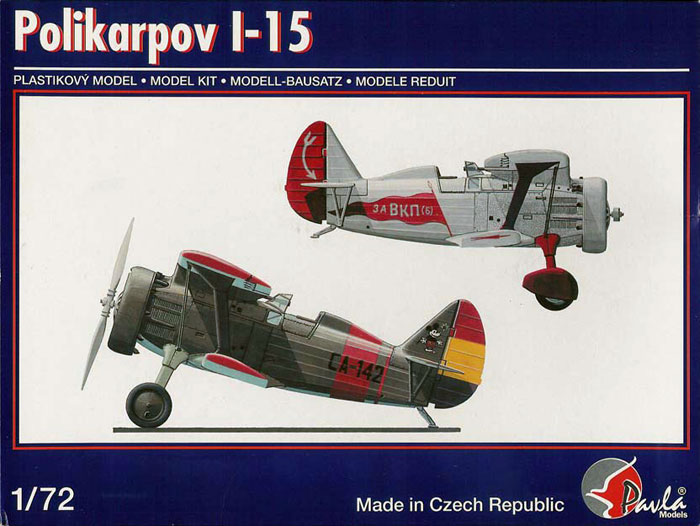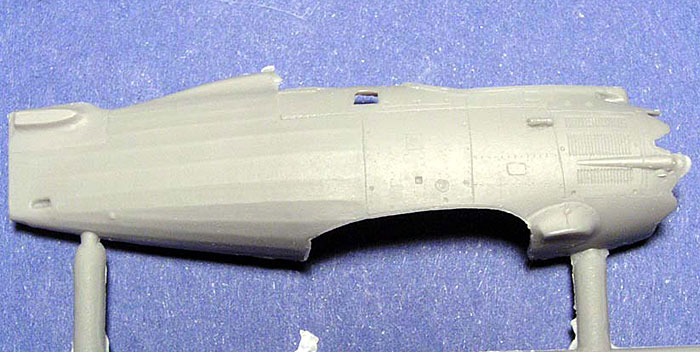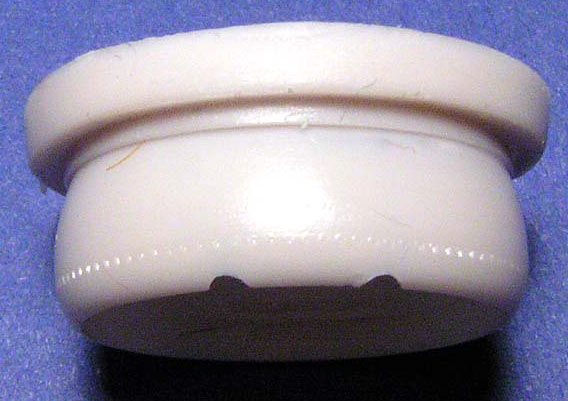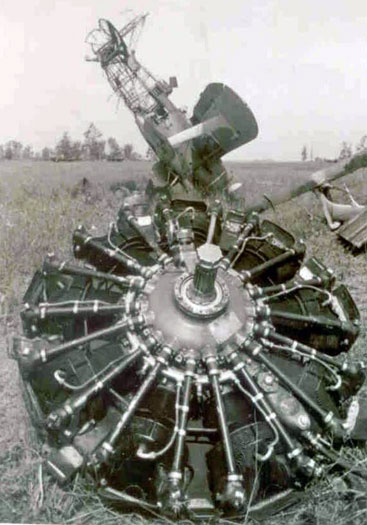|
Polikarpov I-15

Pavla Models, 1/72 scale
S
u m m a r y
|
| Catalogue Number: |
72047 |
| Scale: |
1/72 |
| Contents and Media: |
34, grey,
injection molded styrene and 2 clear vac-form windshields. 10 parts in
pale cream-colored resin.. Decal sheet. Instructions and painting guide
for 5 aircraft. |
| Price: |
USD
$24.47 from Squadron.com |
| Review Type: |
FirstLook |
| Advantages: |
Crisp,
engraved panel lines and wing fabric and ribbing; excellent resin parts;
colorful markings decals; clear instructions. |
| Disadvantages: |
Requires care
in cutting cowl from resin block |
| Recommendation: |
Recommended for moderate to
experienced modelers who would enjoy modeling one of the last of the
bi-plane fighters. |
Reviewed by Steven "Modeldad" Eisenman

Pavla's
1/72 scale Polikarpov I-15 is available online from Squadron
In 1934 the Polikarpov I-15 joined the line of Polikarpov biplane
fighters that began with the I-5 and ending with the I-153. The I-15 was
an immense advancement over the original I-5 primarily because of its
American connection. Having just established diplomatic relations with
the United States, the Soviet Union was able to buy the powerful Wright
Cyclone engine directly from Wright in New Jersey. The availability of
this power plant allowed the Soviet designers to concentrate on creating
a light, fast aerodynamic aircraft, which was one of the most advanced
designs in the world. But the Soviets would quickly replace the Wright
engine on the production line with the powerful Soviet built M-25.
But it was in the Spanish Civil War that the I-15 would attain it
reputation as a nimble fighter, and be nicknamed “Chato” (Snub-Nose).
The Nationalist, thinking the I-15 was American made, because it bore a
resemblance to Curtiss biplanes, nicknamed it the “Curtiss”. It was in a
Chato that the first American pilot shot down a Bf 109. Frank Tinker, an
American volunteer in the Republican Air force, shot down two Bf 109s .
In fact, 109 pilots were warned of the danger of tangling with a Chato
in close combat.
For such a little bit of a model of a little bit of an aircraft, the
cleanly injection molded plastic has very nice detail.

Click the thumbnails below
to view larger images:
The ribbing on the one piece upper and lower wings is well done and
quite delicate looking.
The only thing I would do is to carefully remove the raised
representations of bomb rack attachments on the lower wing. Even thought
the I-15 could carry small bombs and rocket on its wings, it was rarely
done, and the racks were usually removed.
Assembly appears straight forward. But great care will be needed in
separating the cowling from its resin molding block, as well as removing
some of the smaller molded parts from the relatively large sprue gates.

Markings
While the actual color schemes are quite basic, it is the colorful
marking which will make this little bit of a thing stand out. There are
markings for three Republican, one nationalist and one Soviet aircraft.

The Republican machines are in a dark green topside, with light blue
undersides. The instructions indicate that the FS approximation for the
dark green is 43151. The first two numbers were transposed, and it
should be 34151. The blue is given an FS approximation of 35450. All the
aircraft have red wing tips on both top and bottom of both wings, and a
red fuselage band. They also have, of course, the red, yellow and purple
striped rudder.
 The
first Republican I-15 is coded CA-142 and has the Mickey Mouse emblem on
the fin. This aircraft also has an additional thin red fuselage band,
which is supplied as a decal. The
first Republican I-15 is coded CA-142 and has the Mickey Mouse emblem on
the fin. This aircraft also has an additional thin red fuselage band,
which is supplied as a decal.
The second Republican machine is coded CA-151 and represents an aircraft
of the “Patrulle de los Torros”, which undertook the defense of
Barcelona and Valencia. The rudder has the bull’s head symbol and the
large number 151 across it.
The third Republican Chato is CC-011. This aircraft was flown by the son
of the prime minister of the Spanish republic. It does not have any
additional distinctive markings
The Spanish Nationalist aircraft is a post-civil war trainer coded
3*164. It is simply dark green over light blue. It carries the Spanish
roundels of red and yellow in four positions and has the Saint Andrews
cross on the white rudder. To model this aircraft, you must make a
slight alteration to the cockpit entrance on both sides. Unlike the
fighters, the access was slightly curved. This is well shown on the
color and marking drawings. Also, the gun sight was usually removed,
although the drawing shows it in place.
The Soviet I-15 is a brightly colored affair. It is overall aluminum
dope with red landing gear, rudder and inter-plane struts. It carries
the red star in two positions on the bottom of the lower wing. It
carries a red pennant on the sides of the fuselage with Russian script
and a black curved arrow on the tail. This aircraft was used in public
displays.
This is a quite nice kit for those interested in pre-WWII bi-planes
or the Soviet Air Force.
For those who are afraid of models of bi-planes, this is a good
aircraft to start with. Because of it gull-wing design, the upper wing
attaches directly to the fuselage and there are only two inter-plane
struts to worry about. And not much rigging at that.
If you are at all interested in the Polikarpov biplane fighter, I would
also recommend that you get the Squadron/Signal Polikarpov Fighters in
Action Pt. 1.
Thanks to
Squadron.com for the review sample
Review and Images Copyright © 2004 by
Steven Eisenman
Page Created 19 May, 2004
Last updated 19 May, 2004
Back to HyperScale Main Page
Back to Reviews Page
|
Home | What's
New | Features
| Gallery |
Reviews | Reference
| Forum
| Search